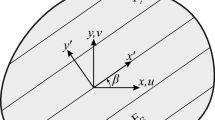Abstract
A model is presented which can be used to incorporate the effects of friction and tortuosity along crack surfaces through a constitutive law applied to the interface between opposing crack surfaces. The problem of a crack with a saw-tooth surface in an infinite medium subjected to a far-field shear stress is solved and the ratios of mode I stress intensity to mode II stress intensity are calculated for various coefficients of friction and material properties. The results show that tortuosity and friction lead to an increase in fracture loads and alter the direction of crack propagation.
Résumé
On présente un modèle utilisable pour tenir compte des effets de friction et de la rugosité sur les surfaces d'une fissure, en appliquant une loi constitutive à l'interface entre les surfaces opposées d'une fissure. On résoud le problème d'une fissure présentant une surface en dents de scie, dans un milieu infini soumis à un champ de contrainte de cisaillement appliqué à une certaine distance. On calcule les rapports de l'intensité de contraintes relative au mode I sur celle relative au mode II, pour divers coefficients de friction et diverses propriétés de matériau. Les résultats montrent que la rugosité et la friction conduisent à un accroissement de la charge correspondant à la rupture, et à une altération de la direction de propagation de la fissure.
Similar content being viewed by others
References
J. P.Clech, L. M.Keer and J. L.Lewis, Journal of Biomechanical Engineering 107 (1985) 175–182.
Z. P.Bazant and P.Gambarova, Journal of the Structural Division, ASCE 106 (1980) 819–842.
R. Jimenez-Perez, P. Gergely and R. N. White, Report 78-4. Department of Structural Engineering, Cornell University (1978).
R. C. Fenwick and T. Paulay, Journal of the Structural Division, ASCE (1968) 2325–2350.
A. R. Ingraffea and W. H. Gerstle, in Application of Fracture Mechanics to Cementitious Composites, S. P. Shah (ed.), Martinus Nijhoff (1985) 247–285.
H. R.Riggs and G. H.Powell, Journal of the Engineering Mechanics Division, ASCE 112 (1986) 448–464.
M. E. Plesha, International Journal for Numerical and Analytical Methods in Geomechanics, in press.
F. P. Bowden and D. Tabor, The Friction and Lubrication of Solids-Part II, Oxford University Press (1965).
J. S.Courtney-Pratt and E.Eisner, Proceedings of the Royal Society of London A 238 (1957) 529–550.
R. E. Goodman, F. E. Heuze and Y. Ohnishi, Research on Strength-Deformability-Water Pressure Relationship for Faults in Direct Shear, Final Report on ARPA Contract H02100200, University of California (1972).
B. Fredriksson, On Elastic Contact Problems With Friction, No. 6, Linkoping Studies in Science and Technology (1976).
Z. P.Bazant and P.Gambarova, Journal of the Structural Division, ASCE 106 (1980) 297–315.
A.Gerasoulis, Comput. Math. Appl. 8 (1982) 15–22.
R. Ballarini, International Journal of Fracture 33 (1987).
D. Broek, Elementary Engineering Fracture Mechanics, Martinus Nijhoff (1982).
Author information
Authors and Affiliations
Rights and permissions
About this article
Cite this article
Ballarini, R., Plesha, M.E. The effects of crack surface friction and roughness on crack tip stress fields. Int J Fract 34, 195–207 (1987). https://doi.org/10.1007/BF00019717
Received:
Accepted:
Issue Date:
DOI: https://doi.org/10.1007/BF00019717



